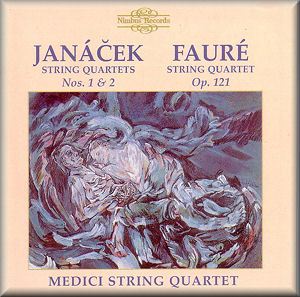 |
 |
| 
Buy
through MusicWeb
for £12 postage paid World-wide.
Musicweb
Purchase button
Sound Samples and Downloads |
Leoš JANÁČEK
(1854-1928)
String Quartet No. 1, The Kreutzer Sonata (1924) [18:27]
String Quartet No. 2, Intimate Letters (1928) [24:58]
Gabriel FAURE (1845-1924)
String Quartet in E minor, Op. 121 (1924) [29:10]
 Medici String Quartet
Medici String Quartet
rec. Nimbus Records, Wyastone Leys, Monmouth, November 1987 (Intimate
Letters) and January 1988
 NIMBUS NI5379 [72:35]
NIMBUS NI5379 [72:35] 
|
|
|
This performance of the Janáček’s First Quartet is very
fine indeed. The tension between the two protagonists of the
Tolstoy novel that inspired the work, as portrayed in the first
movement, is perfectly brought out by the Medici Quartet, as
is the coquettish character of much of the second. The third
movement portrays the tragic act, dramatically played out here.
My only disappointment, and it is a marginal one, is the tempo
chosen for the main part of the finale. Had this been a little
more rapid the repeated dotted note accompaniment figures might
have been more urgent and less heavy, and the closing pages
even more stunning than they already are in this performance.
There can be no doubts at all about the performance of the Second
Quartet. It is one of the finest available, and the finest I
have heard by a non-Czech quartet. The sul ponticello
effects in the first movement will surprise some listeners accustomed
to other performances: they are very drawn out and remarkably
spectral. I was unsure about this at first, but repeated listening
has convinced me. It was at the first hearing, though, that
I excitedly signalled the startling high trills just before
the end of the first movement, superbly executed by this remarkable
ensemble. The rapid scrubbing passages in the second movement
sound dynamic here, but above all, beautiful. There is a “lift”
to the lilting rhythm of the third movement that many quartets
do not achieve, and I find it appropriate and moving. Then the
finale is a tour de force, played with stunning virtuosity,
seemingly about to break the bounds of the medium, astonishingly
fervent and passionate. This is a great performance and one
that deserves its place in every collector’s shelves.
It is well known that the remarkable series of masterpieces
Janáček composed in the last years of his life were inspired
by his love for a much younger woman, Kamila Stösslová. Indeed,
the “Intimate Letters” Quartet is in some ways her portrait,
and a portrait of the composer’s feelings for her. Surprisingly
violent, then, but a supreme expression of almost overpowering
and explosive passion. By contrast, Fauré’s only string quartet,
also composed in the last year of his life, is a work of Olympian
calm. His later music, frequently sombre in nature, is almost
totally free of demonstrative effect and surface gesture. The
music can seem austere, though never sparse in harmony or texture.
It is detached and cool, though never cold. It is music distilled,
pared down in such a way as to leave only the essentials. I
am aware, here, that many of the words I am using also appear
in Geoffrey Crankshaw’s excellent booklet note, but rather than
simple plagiarism, this is a manifestation of what Martin Cooper
wrote in his famous book French Music (OUP, 1951): “To
give in words anything approaching the quality and flavour of
this music written by Fauré in his old age is impossible.” Best
not to try, then. The listener should simply give himself over
to this uncompromising music, seemingly from another world than
Janáček’s, but just as profoundly satisfying in its own
way. The Medici Quartet’s performance is masterly.
I imagine most collectors will be attracted to this disc by
the Janáček, in which case I feel duty bound to point out
that no serious student of the composer should miss out on Czech
performances of these works. The young Skampa Quartet on Supraphon
are particularly fine, but you won’t get any more music. Several
older Czech performances, also on Supraphon, are not to be missed
either. But this Nimbus disc is outstanding too, and collectors
shouldn’t hesitate. The recording is excellent, detailed and
vivid; there is a very capable essay on Janáček by Patrick
Lambert; and if the coupling leads an unsuspecting listener
into the rarefied world of late Fauré, so much the better.
William Hedley
|
|

